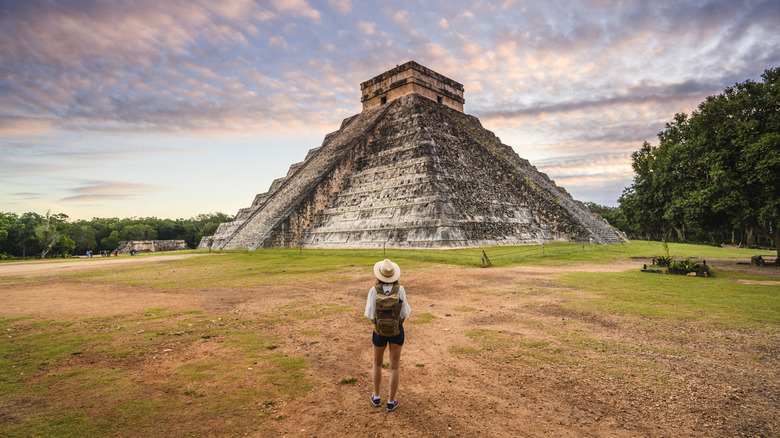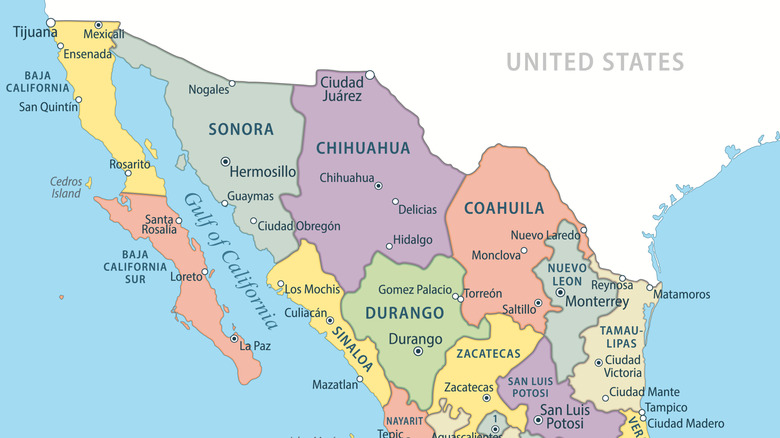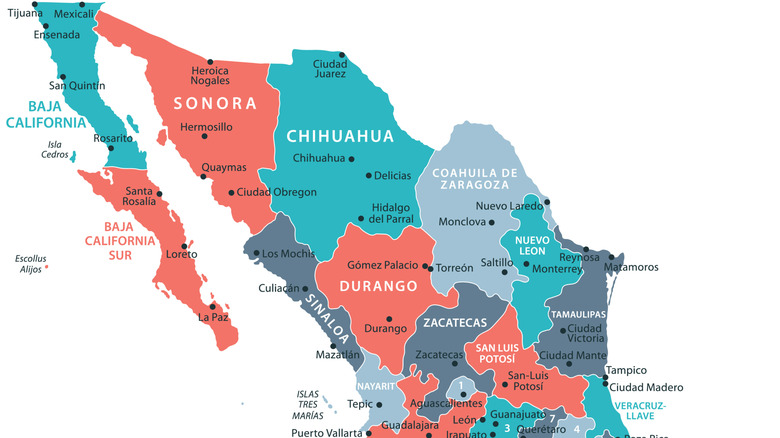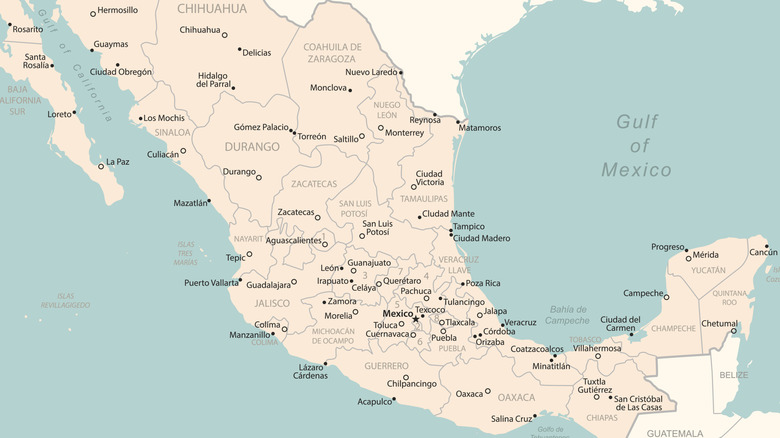The Only Map Of Mexico You Need For Your Upcoming Trip
Mexico is a country with an allure that's hard to resist. After all, nowhere exerts a greater pull on visitors from the United States, who — year after year — choose Mexico as their number one foreign destination. It's a massive, diverse land that offers something for everyone willing to take the time to plan and explore, and while plenty of sun-worshippers flock to the big beach resorts of Cancún and Puerto Vallarta, there are also many underrated destinations to add to your bucket list.
The question is: Where to start? Mexico boasts not only the sparkling stretches of sand it's so famous for, but also scenic deserts, deep canyons, rugged highlands, lush jungles, smoldering volcanoes, and ancient ruins that will awaken your inner Indiana Jones. It's also home to some of North America's most vibrant and vital cities, along with picturesque colonial towns that seem to have stepped straight out of the pages of a novel, such as this spot often called the "City of Eternal Spring."
Perhaps the best way to plan your next jaunt into Mexico is by sitting down and poring over a map of the place. Given its size and diversity, this can be a daunting task, so we've gone ahead and separated Mexico into several distinct regions, highlighting the best spots in each. This will hopefully not only help inform you of what each area has to offer, but also inspire you to head out to see what they look like in person.
Baja California
Thrusting 760 miles southward from the U.S. border like a rocky arm, Baja California (which translates to "Lower California") is actually composed of two states: Baja California and Baja California Sur. This arid peninsula is home not only to spectacular desert views, but also amazing beaches, sleepy towns, and world class snorkeling and diving locations. It's also a nature-lovers paradise, with plenty of opportunities to spot birds and other wildlife, along with some of the best whale watching on the Pacific Coast.
The region's biggest city is Tijuana, a storied border settlement of well over two million people. This buzzing metropolis is a cultural powerhouse that not only delivers deep Mexican culture, but also boasts impressive urban art, along with a terrific food and craft beer scene. While Tijuana has dealt with serious security issues over the past few years, it's still a popular tourist destination, and there are ways to stay safe during any visit.
Baja California's greatest charms lie in its natural splendors, however, especially along its dual coastlines. Surfers flock to its Pacific shores to catch epic waves, while the more tranquil waters of the Gulf of California attract kayakers, bird watchers, and those keen to take in the wondrous sea life blossoming beneath the surface of the water. The southern tip of the peninsula also offers glitz and glamor in the upscale resorts of Cabo San Lucas, one of Mexico's premier beach spots. Also worth checking out is the artsy colonial gem of Todos Santos, along with the gorgeous city of La Paz, where — between swimming with dolphins and sea turtles — you can dive into some of the best seafood in the country.
Northern Mexico
Encompassing a vast area spread out over seven states including Sonora, Chihuahua, Coahuila, Nuevo Leon, Tamaulipas, Durango, and Sinaloa, Mexico's north is dominated by commerce. Its proximity to the United States means that this is where goods flow back and forth across the border. This, along with its ranching and mining riches, make it the country's most wealthy region. While business rules the roost here, Northern Mexico is also home to some of the country's most striking natural treasures, and — given its size and rugged terrain — it also sees far fewer visitors than other parts of the country, lending it a real sense of authenticity.
The region's largest city is Monterrey, a thriving commercial hub that is known for its entrepreneurial spirit, dynamic cultural scene, and vibrant youth culture. Other notable towns include historic Chihuahua City, picturesque Durango (which boasts a baroque-style cathedral), and Ciudad Juárez, a sprawling border city which has been sadly plagued by cartel violence (and therefore best avoided). Much of Northern Mexico is relatively uninhabited, which means its natural attractions are unspoiled, and the undisputed crown jewel is Copper Canyon.
This Grand Canyon of Mexico is actually a network of six massive ravines that join together to form a natural wonder that's four times as large as its counterpoint in the U.S. Best of all, it can be accessed on the El Chepe, also called the Copper Canyon Railroad, that links the town of Los Mochis on the coast to Chihuahua City. Other bucket-list worthy spots in Mexico's wild north include Cola de Caballo (a stunning waterfall near Monterrey), as well as one of North America's most underrated national parks.
Central Mexico
If you're looking for Mexico in its most concentrated form, the country's populous central region (including Aguascalientes, Guanajuato, Querétaro, Hidalgo, Mexico City, Morelos, Puebla, and Tlaxcala) is the place to go. From the beautiful highland towns built by silver mining to the idyllic beaches of the Pacific Coast, this part of the country is known for its diversity, culinary riches, and deep culture on display. It's also home to several of the country's largest cities, including the thrumming and beguiling capital, Mexico City.
The central Pacific Coast offers some of Mexico's best opportunities for fun in the sun. For an authentic experience without the crowds, head to the underrated city of Mazatlán in the north (which boasts over 12 miles of beaches), or check out one of several terrific seaside towns along 200 miles of the Riviera Nayarit. The star of the show, however, is Puerto Vallarta, which is Mexico at its most scenic, accessible, and LGBTQ+ friendly to boot. To the south (in the state of Guerrero), is the resort city of Acapulco, which — while once a magnet for the rich and famous — is now gripped in drug gang turf warfare, and is no longer a safe destination.
The towns of the Central Highlands — places such as San Miguel de Allende (a must-visit for foodies) and the UNESCO World Heritage Sites of Guanajuato and Morelia, are not just rich in history but also boast colonial architecture that make them among the most magical spots in the country. It's here you'll also find Guadalajara, the country's buzzing second city and culinary hub — not to mention the birthplace of tequila and Mariachi. However, it's Mexico City that is the real powerhouse, a creative, global metropolis that is not only filled with tree-lined streets, wide plazas, and dazzling buildings, but also home to one of Latin America's oldest and largest parks.
Southern Mexico
Composed of the states of Oaxaca, Veracruz, Tabasco, and Chiapas, Southern Mexico is raw and magical, a place of coffee plantations, pristine rivers and waterfalls, Mayan ruins rising from the jungle, and villages that will have you feeling like you've stepped back in time. Heroica Veracruz is a harborside settlement that mixes historical charm and port town grit, and remains the nation's most important outlet to the Gulf of Mexico. However, the city of Oaxaca remains the region's main urban draw, and for good reason: This gorgeous colonial town boasts some of the country's most unique and iconic art, while also wearing the crown of Mexico's culinary capital. The nearby Oaxacan coast is also dotted with great, sleepy beaches, including the laid-back coastal town of Puerto Escondido.
Heading further south, you'll come into Chiapas, which is Mexico at its most untamed. This state is a natural wonderland, with hidden valleys, picture-perfect waterfalls, as well as this captivating canyon that offers endless outdoor adventure. In the Chiapas highlands sits the town of San Cristóbal de las Casas — one of the country's great colonial gems — and just three hours down the road lies Palenque. These less-visited Mayan ruins rise starkly from the jungle and offer a glimpse into a bygone city that has only seen 10% of its buildings explored.
The Yucatán Peninsula
The Yucatán is where Mexico meets the Caribbean — whose turquoise waters and immaculate white sand beaches are the country's greatest tourist draw. This all starts with the resort city of Cancún, which not only offers sun-kissed seaside splendor, but also a buzzing nightlife and party scene. Cancún, however, has arguably become a victim of its own success, and now has a reputation as a tourist trap with an abnormally high amount of fraud and scams. This has caused some travelers to seek out quieter spots such as nearby Playa del Carmen or Tulum, which features excellently-preserved Mayan ruins, as well as the beaches that bring people to the Yucatán to begin with.
On the other side of the Yucatán Peninsula sits the Emerald Coast, a 61-mile stretch of shoreline along the Gulf of Mexico that acts as a terrific alternative to the more developed (and crowded) Caribbean side. Accessible from the colorful, festive, and very safe city of Mérida, the Emerald Coast features quiet beaches perfect for kitesurfing and windsurfing, mangroves home to flamingos and other avian species, as well as sleepy fishing villages ideal for off-the-beaten-path day trips.
No trip to the Yucatán would be complete without swimming in the cool, crystal-clear waters of a cenote, the limestone sinkholes found throughout the region. This system of waterways and submerged passages dates back to the Chicxulub meteor impact, which wiped out the dinosaurs some 66 million years ago. While a dip in a cenote is certain to be a once-in-a-lifetime experience, more adventurous swimmers can don a mask and fins and freedive deep into one of these submerged caves, experiencing a unique underwater ecosystem surrounded by a world of water and stone.





